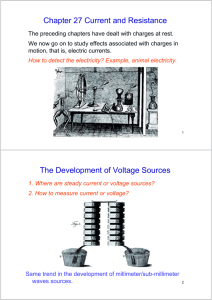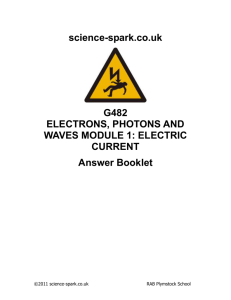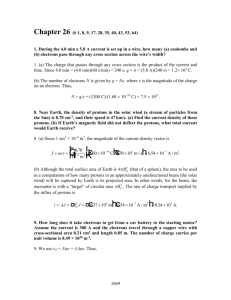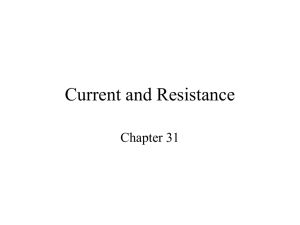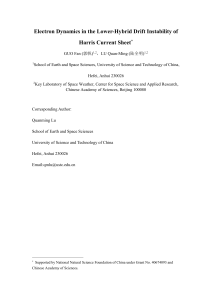Free electron motion
advertisement
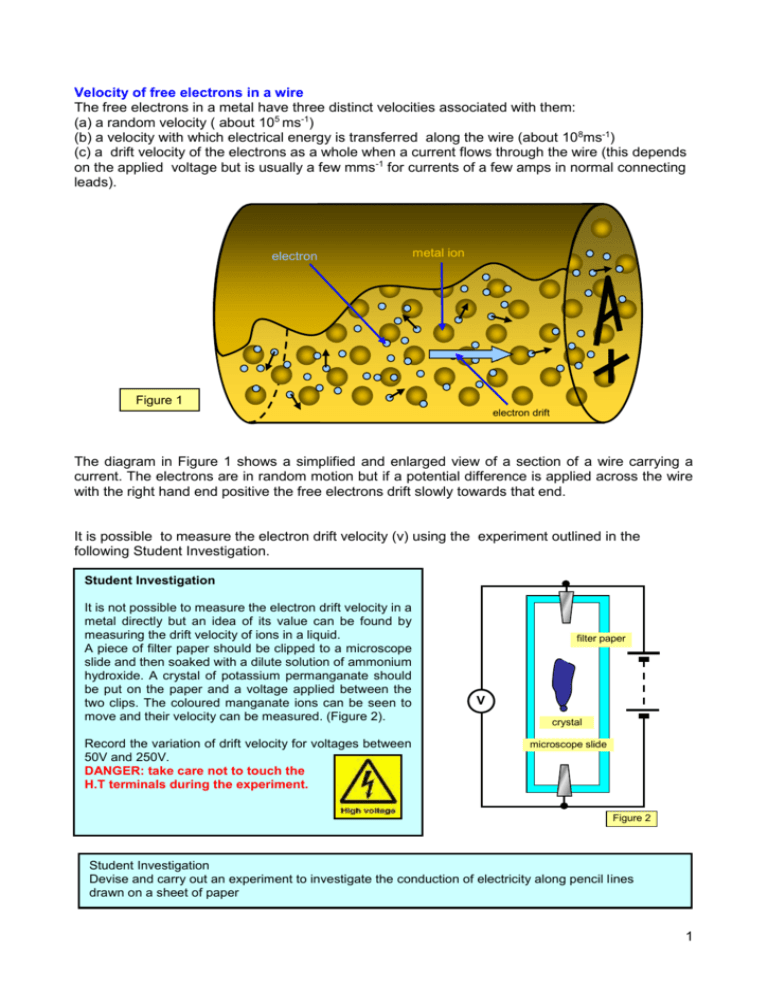
Velocity of free electrons in a wire The free electrons in a metal have three distinct velocities associated with them: (a) a random velocity ( about 105 ms-1) (b) a velocity with which electrical energy is transferred along the wire (about 108ms-1) (c) a drift velocity of the electrons as a whole when a current flows through the wire (this depends on the applied voltage but is usually a few mms-1 for currents of a few amps in normal connecting leads). electron metal ion Figure 1 electron drift The diagram in Figure 1 shows a simplified and enlarged view of a section of a wire carrying a current. The electrons are in random motion but if a potential difference is applied across the wire with the right hand end positive the free electrons drift slowly towards that end. It is possible to measure the electron drift velocity (v) using the experiment outlined in the following Student Investigation. Student Investigation It is not possible to measure the electron drift velocity in a metal directly but an idea of its value can be found by measuring the drift velocity of ions in a liquid. A piece of filter paper should be clipped to a microscope slide and then soaked with a dilute solution of ammonium hydroxide. A crystal of potassium permanganate should be put on the paper and a voltage applied between the two clips. The coloured manganate ions can be seen to move and their velocity can be measured. (Figure 2). Record the variation of drift velocity for voltages between 50V and 250V. DANGER: take care not to touch the H.T terminals during the experiment. filter paper V crystal microscope slide Figure 2 Student Investigation Devise and carry out an experiment to investigate the conduction of electricity along pencil lines drawn on a sheet of paper 1 Electron drift velocity You can work out an equation for the electron drift velocity as follows: Consider a wire of cross sectional area A and carrying a current I amps. Let the number of free electrons per unit volume be n and the drift velocity be v. (See Figure 3). v A e e Figure 3 In one second an electron will have moved a distance v down the wire but since there are n electrons per unit volume the total number moving through this distance will be nAv. Therefore since the charge on an electron is e the current I (which is the charge moving past any point in the wire) is: Current (I) = nAve The table below shows some free electron concentrations Metal Lithium Sodium Silver Copper Free electron concentration (m-3) (at 300 K) 4.7x1028 2.7x1028 5.9x1028 8.5x1028 Example problems 1. Calculate the drift velocity of electrons in a copper wire of cross sectional area 2x10 -7 m2 (0.5mm diameter) carrying a current of 0.5A. (n = 8.5x1028) v = I/nAe = 0.5 /[8.5x1028x2x10-7x1.6x10-19] = 1.84x10-4ms-1 = 0.184mms-1 2. A motorist switches on their headlights. If the distance along the copper connecting wires between the car battery and one of the lights is 1.5 m what is the average time that an individual electron will take to drift between the battery and the light? Take the current in the wire to be 3A, and the cross sectional area of the wire to be 3x10-7 m2. v = I/nAe = 3 /[8.5x1028x3x10-7x1.6x10-19] = 7.4x10-4ms-1 = 0.74 mms-1 Therefore time taken = 1.5/7.4x10-4 = 4080 s = 1.13 hours 2 The electron steeplechase When a current flows round a series circuit the current at any point in the circuit is the same. The same number of electrons flow past any point in the circuit every second no electrons are lost. Although the number of electrons is always the same their energy gets less as they move round the circuit. This energy appears as heat, light or magnetism in say an electrical heater, a light bulb or an electromagnet. Figure 3 You can compare this energy loss with the change in energy of runners in a steeplechase. The energy loss of the athletes when going over the barriers represents the energy that electrons transfer when they pass through a resistor. 3

